JavaFX TreeView Example
This is a JavaFX TreeView example. A TreeView is a control that displays hierarchical data in a tree-like structure. Each item in a TreeView is an instance of the TreeItem class. The following example creates and displays a TreeView with different kinds of vehicles.
The TreeView class is defined in the javafx.scene.control package of the JavaFX API. The following examples uses Java SE 7 and JavaFX 2.2.
This article’s example is built in four steps.
- The first example shows, how a TreeView is created
- The second example handles TreeItem Events
- The third example shows, how the cells in a TreeView can be editable
- The fourth example describes, how items in a tree can be added or removed
1. The TreeViewHelper Class
This is a helper class. This:
- Creates the Items
- Constructs the TreeView Structure
1.1. The Code
TreeViewHelper.java
import java.util.ArrayList;
import javafx.scene.control.TreeItem;
public class TreeViewHelper
{
public TreeViewHelper()
{
}
// This method creates an ArrayList of TreeItems (Products)
public ArrayList<TreeItem> getProducts()
{
ArrayList<TreeItem> products = new ArrayList<TreeItem>();
TreeItem cars = new TreeItem("Cars");
cars.getChildren().addAll(getCars());
TreeItem buses = new TreeItem("Buses");
buses.getChildren().addAll(getBuses());
TreeItem trucks = new TreeItem("Trucks");
trucks.getChildren().addAll(getTrucks());
TreeItem motorbikes = new TreeItem("Motorcycles");
motorbikes.getChildren().addAll(getMotorcycles());
products.add(cars);
products.add(buses);
products.add(trucks);
products.add(motorbikes);
return products;
}
// This method creates an ArrayList of TreeItems (Cars)
private ArrayList<TreeItem> getCars()
{
ArrayList<TreeItem> cars = new ArrayList<TreeItem>();
TreeItem ferrari = new TreeItem("Ferrari");
TreeItem porsche = new TreeItem("Porsche");
TreeItem ford = new TreeItem("Ford");
TreeItem mercedes = new TreeItem("Mercedes");
cars.add(ferrari);
cars.add(porsche);
cars.add(ford);
cars.add(mercedes);
return cars;
}
// This method creates an ArrayList of TreeItems (Buses)
private ArrayList<TreeItem> getBuses()
{
ArrayList<TreeItem> buses = new ArrayList<TreeItem>();
TreeItem gm = new TreeItem("GM");
TreeItem vw = new TreeItem("VW");
TreeItem man = new TreeItem("MAN");
TreeItem volvo = new TreeItem("Volvo");
buses.add(gm);
buses.add(man);
buses.add(volvo);
buses.add(vw);
return buses;
}
// This method creates an ArrayList of TreeItems (Trucks)
private ArrayList<TreeItem> getTrucks()
{
ArrayList<TreeItem> trucks = new ArrayList<TreeItem>();
TreeItem scania = new TreeItem("Scania");
TreeItem mercedes = new TreeItem("Mercedes");
TreeItem gm = new TreeItem("GM");
TreeItem ford = new TreeItem("Ford");
trucks.add(mercedes);
trucks.add(scania);
trucks.add(gm);
trucks.add(ford);
return trucks;
}
// This method creates an ArrayList of TreeItems (Motorbikes)
private ArrayList<TreeItem> getMotorcycles()
{
ArrayList<TreeItem> motorcycles = new ArrayList<TreeItem>();
TreeItem harley = new TreeItem("Harley");
TreeItem suzuki = new TreeItem("Suzuki");
TreeItem ktm = new TreeItem("KTM");
TreeItem honda = new TreeItem("Honda");
motorcycles.add(harley);
motorcycles.add(honda);
motorcycles.add(ktm);
motorcycles.add(suzuki);
return motorcycles;
}
}
1.2. JavaFX Classes Used for Creation of the TreeView
- The TreeItem class is used to construct a single node of the tree
A TreeItem is categorized as a branch or leaf node. If a TreeItem contains other instances of TreeItem, which are called its children, it is called a branch node. Otherwise, it is called a leaf node.
1.3. Creation of the Tree
The following code creates the node cars and adds all objects, which are created by the getCars() – Method, to the node.
TreeItem cars = new TreeItem("Cars");
cars.getChildren().addAll(getCars());
This part will be done also for the node buses, trucks and motorcycles. Thereafter the created nodes will be added to the root node products.
2. The JavaFX TreeView Application – Step 1
This is the main program. This:
- Creates the Gui
- Displays the data in the TreeView
- Allows expanding and collapsing of the nodes
The detailed description follows the code below.
2.1 The Code
FxTreeViewExample1.java
import java.util.ArrayList;
import javafx.application.Application;
import javafx.stage.Stage;
import javafx.scene.Scene;
import javafx.scene.layout.VBox;
import javafx.scene.control.TreeItem;
import javafx.scene.control.TreeView;
public class FxTreeViewExample1 extends Application
{
public static void main(String[] args)
{
Application.launch(args);
}
@Override
public void start(Stage stage)
{
// Create the TreeViewHelper
TreeViewHelper helper = new TreeViewHelper();
// Get the Products
ArrayList<TreeItem> products = helper.getProducts();
// Create the TreeView
TreeView treeView = new TreeView();
// Create the Root TreeItem
TreeItem rootItem = new TreeItem("Vehicles");
// Add children to the root
rootItem.getChildren().addAll(products);
// Set the Root Node
treeView.setRoot(rootItem);
// Create the VBox
VBox root = new VBox();
// Add the TreeView to the VBox
root.getChildren().add(treeView);
// Create the Scene
Scene scene = new Scene(root,400,400);
// Add the Scene to the Stage
stage.setScene(scene);
// Set the Title for the Scene
stage.setTitle("TreeView Example 1");
// Display the stage
stage.show();
}
}
2.2 JavaFx Classes used for GUI
- The Stage class constructs the main window of the application
- The Scene class represents the visual contents of a stage
- The VBox class arranges its children vertically in a single column
- The TreeView class is used to display the data in a tree-like structure
- The TreeItem class is used to construct the root node of the tree
2.3 Create TreeView and Populate with data
The data will be created by using the TreeViewHelper class. The method getProducts() returns an ArrayList of the class TreeItem and the structure of the tree (relations) itself:
// Create the TreeViewHelper TreeViewHelper helper = new TreeViewHelper(); // Get the Products ArrayList<TreeItem> products = helper.getProducts();
The following code creates the TreeView and it´s root node. Thereafter, the products will be added to the root node and the root node itself will be added to the tree.
// Create the TreeView
TreeView treeView = new TreeView();
// Create the Root TreeItem
TreeItem rootItem = new TreeItem("Vehicles");
// Add children to the root
rootItem.getChildren().addAll(products);
// Set the Root Node
treeView.setRoot(rootItem);
2.4 Other Properties
The following are the default properties of the TreeView:
- The cells in a TreeView are not editable
- The TreeView automatically provides vertical and horizontal scrollbars when needed
2.5 The Gui
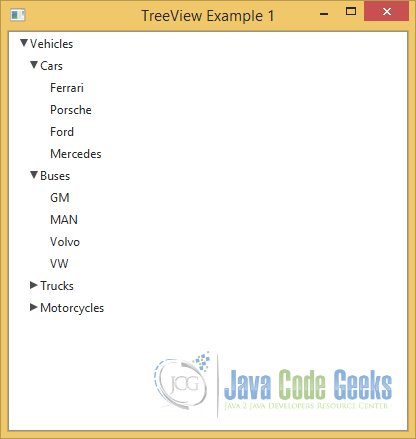
3. The JavaFX TreeView Application – Step 2
The TreeView example is enhanced by handling different TreeItem-Events. A TreeItem fires events as it is modified, for example, by adding or removing children or expanding or collapsing. The following example is enriched by using the branchExpandedEvent and branchCollapsedEvent. Both events are instances of the TreeModificationEvent class.
3.1 The Code
FxTreeViewExample2.java
import java.util.ArrayList;
import javafx.application.Application;
import javafx.scene.Scene;
import javafx.scene.control.Label;
import javafx.scene.control.TextArea;
import javafx.scene.control.TreeItem;
import javafx.scene.control.TreeItem.TreeModificationEvent;
import javafx.scene.control.TreeView;
import javafx.scene.layout.VBox;
import javafx.stage.Stage;
import javafx.event.EventHandler;
public class FxTreeViewExample2 extends Application
{
// Create the TextArea
private final TextArea textArea = new TextArea();
public static void main(String[] args)
{
Application.launch(args);
}
@Override
public void start(Stage stage)
{
// Create the TreeViewHelper
TreeViewHelper helper = new TreeViewHelper();
// Get the Products
ArrayList<TreeItem> products = helper.getProducts();
// Create the TreeView
TreeView treeView = new TreeView();
// Create the Root TreeItem
TreeItem rootItem = new TreeItem("Vehicles");
// Add children to the root
rootItem.getChildren().addAll(products);
// Set the Root Node
treeView.setRoot(rootItem);
// Set tree modification related event handlers (branchExpandedEvent)
rootItem.addEventHandler(TreeItem.branchExpandedEvent(),new EventHandler<TreeItem.TreeModificationEvent>()
{
@Override
public void handle(TreeModificationEvent event)
{
branchExpended(event);
}
});
// Set tree modification related event handlers (branchCollapsedEvent)
rootItem.addEventHandler(TreeItem.branchCollapsedEvent(),new EventHandler<TreeItem.TreeModificationEvent>()
{
@Override
public void handle(TreeModificationEvent event)
{
branchCollapsed(event);
}
});
// Set the preferred number of text rows
textArea.setPrefRowCount(20);
// Set the preferred number of text columns
textArea.setPrefColumnCount(25);
// Create the VBox
VBox root = new VBox();
// Add the TreeView, the Label and the TextArea to the VBox
root.getChildren().addAll(treeView,new Label("Message Log:"), textArea);
// Create the Scene
Scene scene = new Scene(root,400,500);
// Add the Scene to the Stage
stage.setScene(scene);
// Set the Title for the Scene
stage.setTitle("TreeView Example 2");
// Display the stage
stage.show();
}
// Helper Methods for the Event Handlers
private void branchExpended(TreeItem.TreeModificationEvent event)
{
String nodeValue = event.getSource().getValue().toString();
this.writeMessage("Node " + nodeValue + " expanded.");
}
private void branchCollapsed(TreeItem.TreeModificationEvent event)
{
String nodeValue = event.getSource().getValue().toString();
this.writeMessage("Node " + nodeValue + " collapsed.");
}
// Method for Logging
private void writeMessage(String msg)
{
this.textArea.appendText(msg + "\n");
}
}
3.2 Add Event Handlers for TreeItem Events
The following code adds two EventHandler of the instance TreeItem.TreeModificationEvent to the root node. The events are fired, if the user expands or collapse a node. The effect of these events is a logging entry in the TextArea.
// Set tree modification related event handlers (branchExpandedEvent)
rootItem.addEventHandler(TreeItem.branchExpandedEvent(),new EventHandler<TreeItem.TreeModificationEvent>()
{
@Override
public void handle(TreeModificationEvent event)
{
branchExpended(event);
}
});
// Set tree modification related event handlers (branchCollapsedEvent)
rootItem.addEventHandler(TreeItem.branchCollapsedEvent(),new EventHandler<TreeItem.TreeModificationEvent>()
{
@Override
public void handle(TreeModificationEvent event)
{
branchCollapsed(event);
}
});
private void branchExpended(TreeItem.TreeModificationEvent event)
{
String nodeValue = event.getSource().getValue().toString();
this.writeMessage("Node " + nodeValue + " expanded.");
}
private void branchCollapsed(TreeItem.TreeModificationEvent event)
{
String nodeValue = event.getSource().getValue().toString();
this.writeMessage("Node " + nodeValue + " collapsed.");
}
3.3 Add a TextArea for displaying the effect of the Events Handlers
In this section a TextArea is defined for displaying the Messages of the EventHandlers.
// Create the TextArea private final TextArea textArea = new TextArea(); // Set the preferred number of text rows textArea.setPrefRowCount(20); // Set the preferred number of text columns textArea.setPrefColumnCount(25);
The following code represents the method, which displays the message in the TextArea.
// Method for Logging
private void writeMessage(String msg)
{
this.textArea.appendText(msg + "\n");
}
Now it is necessary, that the TextArea and a Label will be added to the VBox.
// Add the TreeView, the Label and the TextArea to the VBox
root.getChildren().addAll(treeView,new Label("Message Log:"), textArea);
3.4 The GUI
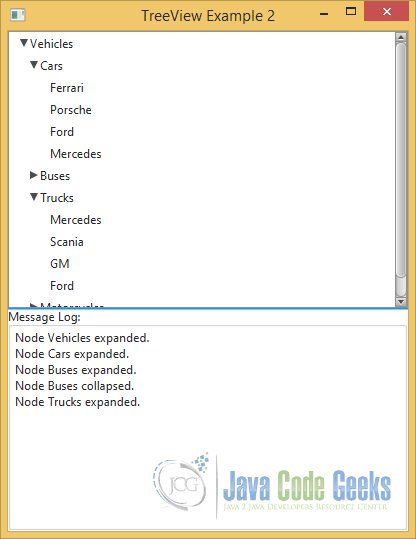
4. The JavaFX TreeView Application – Step 3
This TreeView example is enhanced to have editable cells.
4.1 The Code
FxTreeViewExample3.java
import java.util.ArrayList;
import javafx.application.Application;
import javafx.stage.Stage;
import javafx.scene.Scene;
import javafx.scene.layout.VBox;
import javafx.scene.control.Label;
import javafx.scene.control.TextArea;
import javafx.scene.control.TreeItem;
import javafx.scene.control.TreeView.EditEvent;
import javafx.scene.control.cell.TextFieldTreeCell;
import javafx.scene.control.TreeView;
import javafx.event.EventHandler;
public class FxTreeViewExample3 extends Application
{
// Create the TextArea
private final TextArea textArea = new TextArea();
public static void main(String[] args)
{
Application.launch(args);
}
@Override
public void start(Stage stage)
{
// Create the TreeViewHelper
TreeViewHelper helper = new TreeViewHelper();
// Get the Products
ArrayList<TreeItem> products = helper.getProducts();
// Create the TreeView
TreeView treeView = new TreeView();
// Create the Root TreeItem
TreeItem rootItem = new TreeItem("Vehicles");
// Add children to the root
rootItem.getChildren().addAll(products);
// Set the Root Node
treeView.setRoot(rootItem);
// Make the TreeView editable
treeView.setEditable(true);
// Set a cell factory to use TextFieldTreeCell
treeView.setCellFactory(TextFieldTreeCell.forTreeView());
// Set editing related event handlers (OnEditStart)
treeView.setOnEditStart(new EventHandler<TreeView.EditEvent>()
{
@Override
public void handle(EditEvent event)
{
editStart(event);
}
});
// Set editing related event handlers (OnEditCommit)
treeView.setOnEditCommit(new EventHandler<TreeView.EditEvent>()
{
@Override
public void handle(EditEvent event)
{
editCommit(event);
}
});
// Set editing related event handlers (OnEditCancel)
treeView.setOnEditCancel(new EventHandler<TreeView.EditEvent>()
{
@Override
public void handle(EditEvent event)
{
editCancel(event);
}
});
// Set the preferred number of text rows
textArea.setPrefRowCount(15);
// Set the preferred number of text columns
textArea.setPrefColumnCount(25);
// Create the VBox
VBox root = new VBox();
// Add the TreeView to the VBox
root.getChildren().addAll(treeView,new Label("Message Log:"), textArea);
// Create the Scene
Scene scene = new Scene(root,400,500);
// Add the Scene to the Stage
stage.setScene(scene);
// Set the Title for the Scene
stage.setTitle("TreeView Example 3");
// Display the stage
stage.show();
}
// Helper Methods for the Event Handlers
private void editStart(TreeView.EditEvent event)
{
writeMessage("Started editing: " + event.getTreeItem() );
}
private void editCommit(TreeView.EditEvent event)
{
writeMessage(event.getTreeItem() + " changed." +
" old = " + event.getOldValue() +
", new = " + event.getNewValue());
}
private void editCancel(TreeView.EditEvent e)
{
writeMessage("Cancelled editing: " + e.getTreeItem() );
}
// Method for Logging
private void writeMessage(String msg)
{
this.textArea.appendText(msg + "\n");
}
}
4.2 Editing Data in a TreeView
A cell (node) in a TreeView can be editable. An editable cell may switch between editing and nonediting mode. In editing mode, cell data can be modified by the user. TreeView has an editable property, which can be set to true using the setEditable(true) method, as shown in the following code.
// Make the TreeView editable treeView.setEditable(true);
4.3 Editing Data Using a TextField
A TextFieldTreeCell is rendered as a Label in nonediting mode and as a TextField in editing mode. Its forTreeView() static method returns a cell factory.
// Set a cell factory to use TextFieldTreeCell treeView.setCellFactory(TextFieldTreeCell.forTreeView());
4.4 Event Handler
TreeView supports three types of events:
- onEditStart
- onEditCommit
- onEditCancel
The onEditStart event is fired when a cell enters editing mode. The onEditCommit event is fired
when the user successfully commits the editing, for example, by pressing the Enter key in a TextField.
The following code shows an implementation of the necessary Event Handlers. In this case, a message will be written to the TextArea.
// Set editing related event handlers (OnEditStart)
treeView.setOnEditStart(new EventHandler<TreeView.EditEvent>()
{
@Override
public void handle(EditEvent event)
{
editStart(event);
}
});
// Set editing related event handlers (OnEditCommit)
treeView.setOnEditCommit(new EventHandler<TreeView.EditEvent>()
{
@Override
public void handle(EditEvent event)
{
editCommit(event);
}
});
// Set editing related event handlers (OnEditCancel)
treeView.setOnEditCancel(new EventHandler<TreeView.EditEvent>()
{
@Override
public void handle(EditEvent event)
{
editCancel(event);
}
});
// Helper Methods for the Event Handlers
private void editStart(TreeView.EditEvent event)
{
writeMessage("Started editing: " + event.getTreeItem() );
}
private void editCommit(TreeView.EditEvent event)
{
writeMessage(event.getTreeItem() + " changed." +
" old = " + event.getOldValue() +
", new = " + event.getNewValue());
}
private void editCancel(TreeView.EditEvent e)
{
writeMessage("Cancelled editing: " + e.getTreeItem() );
}
4.5 The Gui
Clicking a selected cell or double-clicking an unselected cell puts the cell into editing mode, which displays the cell data in a TextField.
Once the cell is in editing mode, you need to click in the TextField to put the caret in the TextField so you can make changes.
5. The JavaFX TreeView Application – Step 4
This TreeView allows adding and removing nodes by the user.
5.1 The Code
FxTreeViewExample4.java
import java.util.ArrayList;
import javafx.application.Application;
import javafx.stage.Stage;
import javafx.scene.Scene;
import javafx.scene.layout.HBox;
import javafx.scene.layout.VBox;
import javafx.scene.control.Button;
import javafx.scene.control.Label;
import javafx.scene.control.TreeItem;
import javafx.scene.control.TreeItem.TreeModificationEvent;
import javafx.scene.control.TreeView.EditEvent;
import javafx.scene.control.cell.TextFieldTreeCell;
import javafx.scene.control.TreeView;
import javafx.scene.control.TextArea;
import javafx.scene.control.TextField;
import javafx.event.ActionEvent;
import javafx.event.EventHandler;
public class FxTreeViewExample4 extends Application
{
// Create the TreeView
private final TreeView treeView = new TreeView();
// Create the TextArea
private final TextArea textArea = new TextArea();
// Create the TextField
private TextField textField = new TextField();
public static void main(String[] args)
{
Application.launch(args);
}
@Override
public void start(Stage stage)
{
// Create the TreeViewHelper
TreeViewHelper helper = new TreeViewHelper();
// Get the Products
ArrayList<TreeItem> products = helper.getProducts();
// Make the TreeView editable
treeView.setEditable(true);
// Set a cell factory to use TextFieldTreeCell
treeView.setCellFactory(TextFieldTreeCell.forTreeView());
// Select the root node
treeView.getSelectionModel().selectFirst();
// Create the root node and adds event handler to it
TreeItem rootItem = new TreeItem("Vehicles");
// Add children to the root
rootItem.getChildren().addAll(products);
// Set the Root Node
treeView.setRoot(rootItem);
// Set editing related event handlers (OnEditStart)
treeView.setOnEditStart(new EventHandler<TreeView.EditEvent>()
{
@Override
public void handle(EditEvent event)
{
editStart(event);
}
});
// Set editing related event handlers (OnEditCommit)
treeView.setOnEditCommit(new EventHandler<TreeView.EditEvent>()
{
@Override
public void handle(EditEvent event)
{
editCommit(event);
}
});
// Set editing related event handlers (OnEditCancel)
treeView.setOnEditCancel(new EventHandler<TreeView.EditEvent>()
{
@Override
public void handle(EditEvent event)
{
editCancel(event);
}
});
// Set tree modification related event handlers (branchExpandedEvent)
rootItem.addEventHandler(TreeItem.branchExpandedEvent(),new EventHandler<TreeItem.TreeModificationEvent>()
{
@Override
public void handle(TreeModificationEvent event)
{
branchExpended(event);
}
});
// Set tree modification related event handlers (branchCollapsedEvent)
rootItem.addEventHandler(TreeItem.branchCollapsedEvent(),new EventHandler<TreeItem.TreeModificationEvent>()
{
@Override
public void handle(TreeModificationEvent event)
{
branchCollapsed(event);
}
});
// Set tree modification related event handlers (childrenModificationEvent)
rootItem.addEventHandler(TreeItem.childrenModificationEvent(),new EventHandler<TreeItem.TreeModificationEvent>()
{
@Override
public void handle(TreeModificationEvent event)
{
childrenModification(event);
}
});
// Create the VBox
VBox rightPane = getRightPane();
// Create the HBox
HBox root = new HBox();
// Set the horizontal space between each child in the HBox
root.setSpacing(20);
// Add the TreeView to the HBox
root.getChildren().addAll(treeView,rightPane);
// Create the Scene
Scene scene = new Scene(root,600,500);
// Add the Scene to the Stage
stage.setScene(scene);
// Set the Title for the Scene
stage.setTitle("TreeView Example 4");
// Display the stage
stage.show();
}
// This method creates a VBox and it´s components and returns it to the calling Method
private VBox getRightPane()
{
// Create the addItemBtn and its corresponding Event Handler
Button addItemBtn = new Button("Add new Item");
addItemBtn.setOnAction(new EventHandler()
{
@Override
public void handle(ActionEvent event)
{
addItem(textField.getText());
}
});
// Create the removeItemBtn and its corresponding Event Handler
Button removeItemBtn = new Button("Remove Selected Item");
removeItemBtn.setOnAction(new EventHandler()
{
@Override
public void handle(ActionEvent event)
{
removeItem();
}
});
// Set the preferred number of text rows
textArea.setPrefRowCount(15);
// Set the preferred number of text columns
textArea.setPrefColumnCount(25);
// Create the HBox
HBox hbox = new HBox();
// Add Children to the HBox
hbox.getChildren().addAll(new Label("Item:"), textField, addItemBtn);
// Create the VBox
VBox vbox = new VBox();
// Add children to the VBox
vbox.getChildren().addAll(new Label("Select an item to add to or remove."),hbox,removeItemBtn,
new Label("Message Log:"), textArea);
// Set the vertical space between each child in the VBox
vbox.setSpacing(10);
return vbox;
}
// Helper Method for Adding an Item
private void addItem(String value)
{
if (value == null || value.trim().equals(""))
{
this.writeMessage("Item cannot be empty.");
return;
}
TreeItem parent = treeView.getSelectionModel().getSelectedItem();
if (parent == null)
{
this.writeMessage("Select a node to add this item to.");
return;
}
// Check for duplicate
for(TreeItem child : parent.getChildren())
{
if (child.getValue().equals(value))
{
this.writeMessage(value + " already exists under " + parent.getValue());
return;
}
}
TreeItem newItem = new TreeItem(value);
parent.getChildren().add(newItem);
if (!parent.isExpanded())
{
parent.setExpanded(true);
}
}
// Helper Method for Removing an Item
private void removeItem()
{
TreeItem item = treeView.getSelectionModel().getSelectedItem();
if (item == null)
{
this.writeMessage("Select a node to remove.");
return;
}
TreeItem parent = item.getParent();
if (parent == null )
{
this.writeMessage("Cannot remove the root node.");
}
else
{
parent.getChildren().remove(item);
}
}
// Helper Methods for the Event Handlers
private void branchExpended(TreeItem.TreeModificationEvent event)
{
String nodeValue = event.getSource().getValue().toString();
this.writeMessage("Node " + nodeValue + " expanded.");
}
private void branchCollapsed(TreeItem.TreeModificationEvent event)
{
String nodeValue = event.getSource().getValue().toString();
this.writeMessage("Node " + nodeValue + " collapsed.");
}
private void childrenModification(TreeItem.TreeModificationEvent event)
{
if (event.wasAdded())
{
for(TreeItem item : event.getAddedChildren())
{
this.writeMessage("Node " + item.getValue() + " has been added.");
}
}
if (event.wasRemoved())
{
for(TreeItem item : event.getRemovedChildren())
{
this.writeMessage("Node " + item.getValue() + " has been removed.");
}
}
}
private void editStart(TreeView.EditEvent event)
{
this.writeMessage("Started editing: " + event.getTreeItem() );
}
private void editCommit(TreeView.EditEvent event)
{
this.writeMessage(event.getTreeItem() + " changed." +
" old = " + event.getOldValue() +
", new = " + event.getNewValue());
}
private void editCancel(TreeView.EditEvent e)
{
this.writeMessage("Cancelled editing: " + e.getTreeItem() );
}
// Method for Logging
private void writeMessage(String msg)
{
this.textArea.appendText(msg + "\n");
}
}
5.2 Changes for the GUI
In this example we are using a HBox for the TreeView and a VBox for Buttons, Labels, etc. The VBox represents the right Pane. There exists a Button for adding and removing an item.
// This method creates a VBox and it´s components and returns it to the calling Method
private VBox getRightPane()
{
// Create the addItemBtn and its corresponding Event Handler
Button addItemBtn = new Button("Add new Item");
addItemBtn.setOnAction(new EventHandler()
{
@Override
public void handle(ActionEvent event)
{
addItem(textField.getText());
}
});
// Create the removeItemBtn and its corresponding Event Handler
Button removeItemBtn = new Button("Remove Selected Item");
removeItemBtn.setOnAction(new EventHandler()
{
@Override
public void handle(ActionEvent event)
{
removeItem();
}
});
// Set the preferred number of text rows
textArea.setPrefRowCount(15);
// Set the preferred number of text columns
textArea.setPrefColumnCount(25);
// Create the HBox
HBox hbox = new HBox();
// Add Children to the HBox
hbox.getChildren().addAll(new Label("Item:"), textField, addItemBtn);
// Create the VBox
VBox vbox = new VBox();
// Add children to the VBox
vbox.getChildren().addAll(new Label("Select an item to add to or remove."),hbox,removeItemBtn,
new Label("Message Log:"), textArea);
// Set the vertical space between each child in the VBox
vbox.setSpacing(10);
return vbox;
}
In the main method it is necessary to change the code as follows:
// Create the VBox VBox rightPane = getRightPane(); // Create the HBox HBox root = new HBox(); // Set the horizontal space between each child in the HBox root.setSpacing(20); // Add the TreeView to the HBox root.getChildren().addAll(treeView,rightPane);
5.3 Event Handler for Children Modification
Given the fact, that we want to add / remove items to / from the tree, we have to handle ChildrenModification-Events. The following code shows an example of an EventHandler, which handles an childrenModificationEvent.
// Set tree modification related event handlers (childrenModificationEvent)
rootItem.addEventHandler(TreeItem.childrenModificationEvent(),new EventHandler<TreeItem.TreeModificationEvent>()
{
@Override
public void handle(TreeModificationEvent event)
{
childrenModification(event);
}
});
private void childrenModification(TreeItem.TreeModificationEvent event)
{
if (event.wasAdded())
{
for(TreeItem item : event.getAddedChildren())
{
this.writeMessage("Node " + item.getValue() + " has been added.");
}
}
if (event.wasRemoved())
{
for(TreeItem item : event.getRemovedChildren())
{
this.writeMessage("Node " + item.getValue() + " has been removed.");
}
}
}
5.4 Event Handler for Action Events
An event handler of type ActionEvent is used as a button’s action event handler. The interface EventHandler is implemented for this purpose. The button’s handler property is set as button.setOnaction. This is common for both buttons in this example – add and remove.
// Create the addItemBtn and its corresponding Event Handler
Button addItemBtn = new Button("Add new Item");
addItemBtn.setOnAction(new EventHandler()
{
@Override
public void handle(ActionEvent event)
{
addItem(textField.getText());
}
});
// Create the removeItemBtn and its corresponding Event Handler
Button removeItemBtn = new Button("Remove Selected Item");
removeItemBtn.setOnAction(new EventHandler()
{
@Override
public void handle(ActionEvent event)
{
removeItem();
}
});
// Helper Method for Adding an Item
private void addItem(String value)
{
if (value == null || value.trim().equals(""))
{
this.writeMessage("Item cannot be empty.");
return;
}
TreeItem parent = treeView.getSelectionModel().getSelectedItem();
if (parent == null)
{
this.writeMessage("Select a node to add this item to.");
return;
}
// Check for duplicate
for(TreeItem child : parent.getChildren())
{
if (child.getValue().equals(value))
{
this.writeMessage(value + " already exists under " + parent.getValue());
return;
}
}
TreeItem newItem = new TreeItem(value);
parent.getChildren().add(newItem);
if (!parent.isExpanded())
{
parent.setExpanded(true);
}
}
// Helper Method for Removing an Item
private void removeItem()
{
TreeItem item = treeView.getSelectionModel().getSelectedItem();
if (item == null)
{
this.writeMessage("Select a node to remove.");
return;
}
TreeItem parent = item.getParent();
if (parent == null )
{
this.writeMessage("Cannot remove the root node.");
}
else
{
parent.getChildren().remove(item);
}
}
5.5 The Gui
This section shows an the following examples:
- Adding a Nw Item to the Tree
- Removing an existing Item from the Tree
5.5.1 Add New Items
The user navigates to the node, under which he want to add a new item (children).
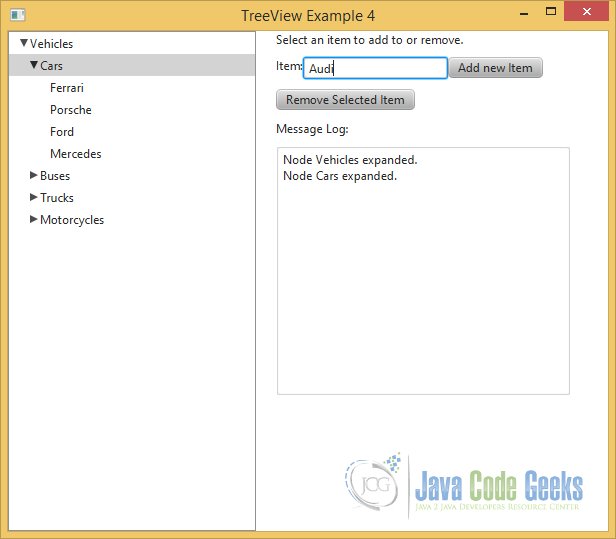
He writes the name into the Textield and clicks the Add button. The action creates a new TreeItem instance and adds it to the data model. The new node is added to the TreeView.

5.5.2 Remove Items
The user selects the node, which he want to remove.
The user clicks the Remove Selected Item button. The action deletes the selected item from the data model and from the TreeView.
6. Download Java Source Code
This was an example of javafx.scene.control.TreeView
You can download the full source code of this example here: JavaFxTreeViewExample.zip

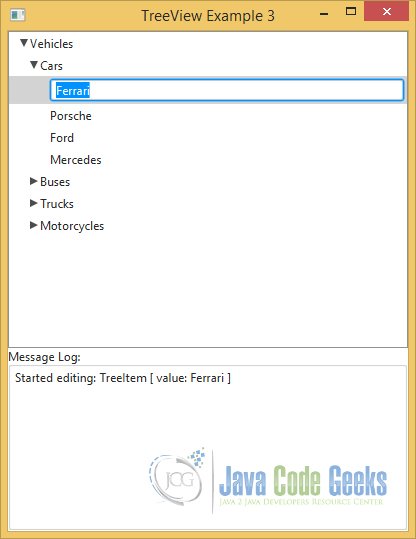
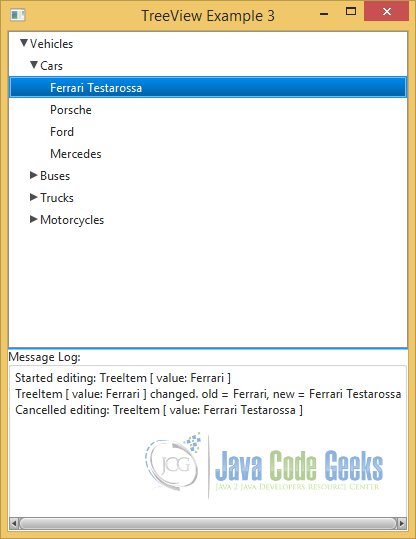
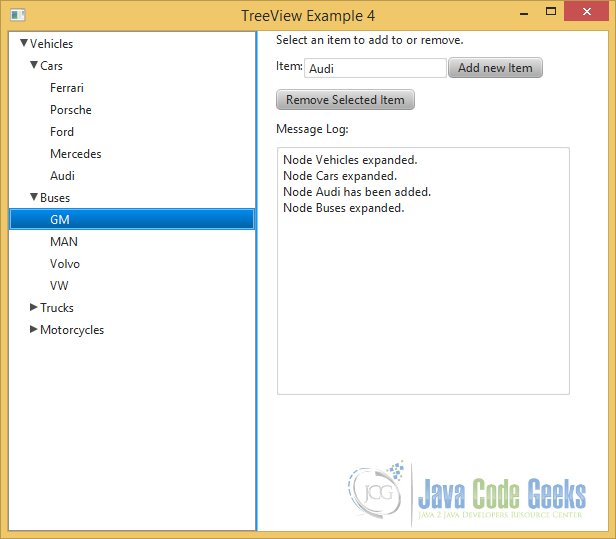
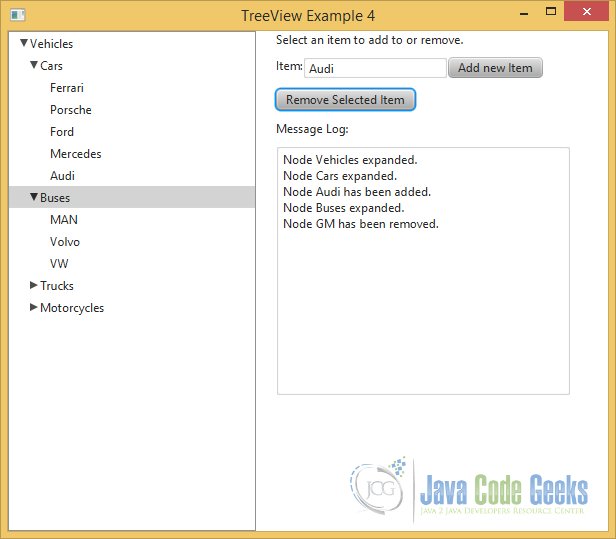


The downloaded code does not match the code of the web page and it does not compile.
I get the error
java: incompatible types: java.util.ArrayList<javafx.scene.control.TreeItem> cannot be converted to java.util.ArrayList<javafx.scene.control.TreeItem<java.lang.String>>
This does not work sadly…